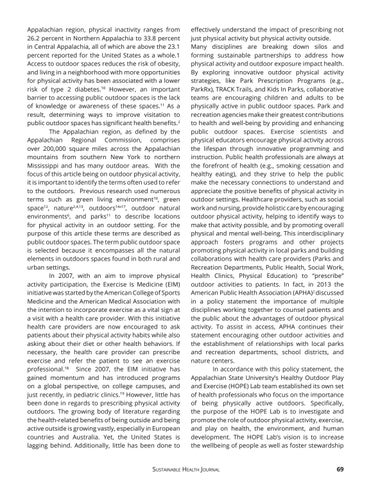Appalachian region, physical inactivity ranges from 26.2 percent in Northern Appalachia to 33.8 percent in Central Appalachia, all of which are above the 23.1 percent reported for the United States as a whole.1 Access to outdoor spaces reduces the risk of obesity, and living in a neighborhood with more opportunities for physical activity has been associated with a lower risk of type 2 diabetes.10 However, an important barrier to accessing public outdoor spaces is the lack of knowledge or awareness of these spaces.11 As a result, determining ways to improve visitation to public outdoor spaces has significant health benefits.2 The Appalachian region, as defined by the Appalachian Regional Commission, comprises over 200,000 square miles across the Appalachian mountains from southern New York to northern Mississippi and has many outdoor areas. With the focus of this article being on outdoor physical activity, it is important to identify the terms often used to refer to the outdoors. Previous research used numerous terms such as green living environment10, green space12, nature2,4,13, outdoors14–17, outdoor natural environments6, and parks11 to describe locations for physical activity in an outdoor setting. For the purpose of this article these terms are described as public outdoor spaces. The term public outdoor space is selected because it encompasses all the natural elements in outdoors spaces found in both rural and urban settings. In 2007, with an aim to improve physical activity participation, the Exercise Is Medicine (EIM) initiative was started by the American College of Sports Medicine and the American Medical Association with the intention to incorporate exercise as a vital sign at a visit with a health care provider. With this initiative health care providers are now encouraged to ask patients about their physical activity habits while also asking about their diet or other health behaviors. If necessary, the health care provider can prescribe exercise and refer the patient to see an exercise professional.18 Since 2007, the EIM initiative has gained momentum and has introduced programs on a global perspective, on college campuses, and just recently, in pediatric clinics.19 However, little has been done in regards to prescribing physical activity outdoors. The growing body of literature regarding the health-related benefits of being outside and being active outside is growing vastly, especially in European countries and Australia. Yet, the United States is lagging behind. Additionally, little has been done to
effectively understand the impact of prescribing not just physical activity but physical activity outside. Many disciplines are breaking down silos and forming sustainable partnerships to address how physical activity and outdoor exposure impact health. By exploring innovative outdoor physical activity strategies, like Park Prescription Programs (e.g., ParkRx), TRACK Trails, and Kids In Parks, collaborative teams are encouraging children and adults to be physically active in public outdoor spaces. Park and recreation agencies make their greatest contributions to health and well-being by providing and enhancing public outdoor spaces. Exercise scientists and physical educators encourage physical activity across the lifespan through innovative programming and instruction. Public health professionals are always at the forefront of health (e.g., smoking cessation and healthy eating), and they strive to help the public make the necessary connections to understand and appreciate the positive benefits of physical activity in outdoor settings. Healthcare providers, such as social work and nursing, provide holistic care by encouraging outdoor physical activity, helping to identify ways to make that activity possible, and by promoting overall physical and mental well-being. This interdisciplinary approach fosters programs and other projects promoting physical activity in local parks and building collaborations with health care providers (Parks and Recreation Departments, Public Health, Social Work, Health Clinics, Physical Education) to “prescribe” outdoor activities to patients. In fact, in 2013 the American Public Health Association (APHA)2 discussed in a policy statement the importance of multiple disciplines working together to counsel patients and the public about the advantages of outdoor physical activity. To assist in access, APHA continues their statement encouraging other outdoor activities and the establishment of relationships with local parks and recreation departments, school districts, and nature centers. In accordance with this policy statement, the Appalachian State University’s Healthy Outdoor Play and Exercise (HOPE) Lab team established its own set of health professionals who focus on the importance of being physically active outdoors. Specifically, the purpose of the HOPE Lab is to investigate and promote the role of outdoor physical activity, exercise, and play on health, the environment, and human development. The HOPE Lab’s vision is to increase the wellbeing of people as well as foster stewardship
Sustainable Health Journal
69
